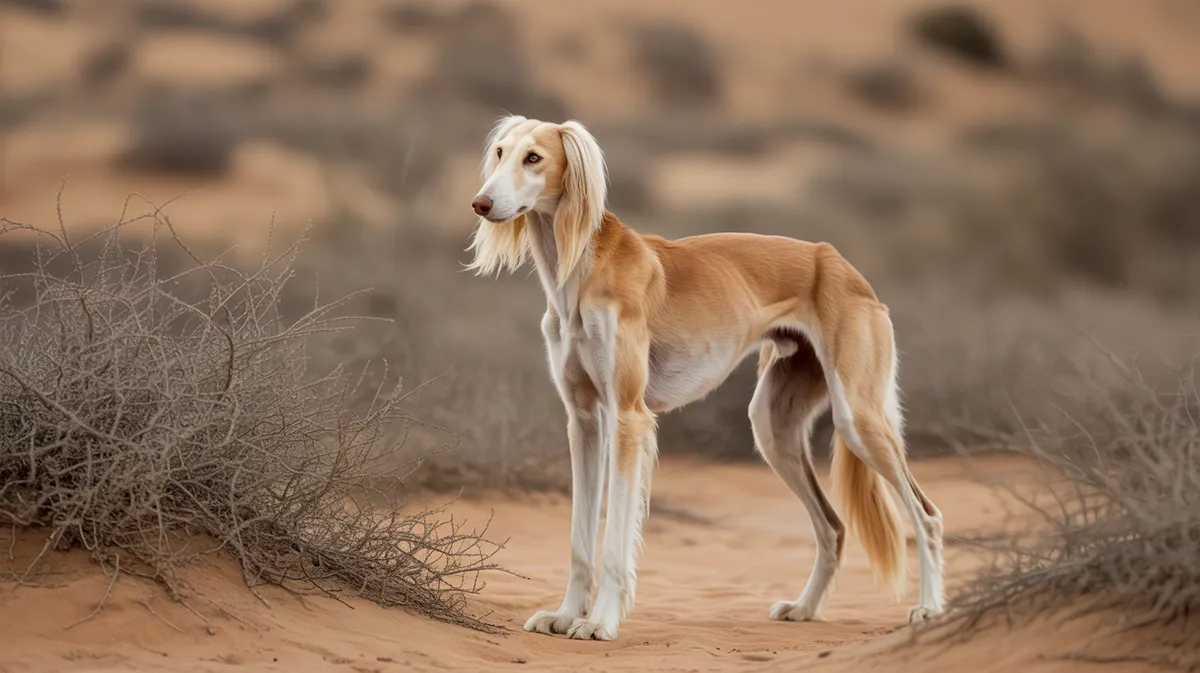
Saluki
Canis lupus familiaris

Meet the Saluki
The Saluki is an ancient breed of dog renowned for its exceptional speed, grace, and endurance. Originally bred in the Middle East for hunting game such as gazelle and hare, Salukis are slender and elegant with long legs and a distinctive feathered tail. They are known for their gentle, reserved temperament and strong loyalty to their families. Salukis have a smooth or feathered coat that comes in a variety of colors, and they are highly athletic, making them excellent companions for active owners.
Classification
Mammal
Habitat
Desert and arid grasslands
Diet
Carnivore
Lifespan
12-14 years
Conservation
Least Concern
Weight
18–27 kg (40–60 lbs)
📖Fascinating Facts
Incredible Speed
Salukis are capable of running at speeds up to 68 km/h (42 mph), rivaling even the Greyhound.
Desert Hunters
The breed was developed in the deserts of the Middle East, where its stamina and speed made it ideal for chasing fast prey over vast distances.
Royal Heritage
Salukis were treasured by ancient Egyptian pharaohs and Bedouin tribes, often depicted in ancient art and kept as noble companions.
📋Detailed Description
The Saluki is a medium to large sighthound, typically standing 58–71 cm (23–28 in) at the shoulder and weighing between 18–27 kg (40–60 lbs). Its anatomy is highly specialized for speed and endurance: a deep, narrow chest houses an enlarged heart and lungs, while long, finely muscled legs and a flexible spine enable a double-suspension gallop, similar to that of the cheetah. The breed exhibits two coat types—smooth and feathered—with the latter featuring silky fringes on the ears, tail, and legs. Salukis have a long, narrow head with large, dark eyes adapted for acute vision, essential for tracking prey over vast distances. Their skin is thin and loose, reducing injury risk from brush or prey. Behaviorally, Salukis are quiet, gentle, and reserved, often forming strong bonds with their families but displaying aloofness toward strangers. They are highly intelligent, independent thinkers, a trait stemming from their history as solitary hunters. In the wild or traditional settings, Salukis may form loose packs but generally hunt alone or in pairs. Reproduction is typical of domestic dogs, with litters averaging 6–8 pups after a gestation of about 63 days. Unique among domestic dogs, Salukis retain many primitive traits, such as a strong prey drive and a metabolism adapted for sustained running in hot, arid environments.
💡 Did you know?
Salukis can reach speeds of up to 68 km/h (42 mph), making them one of the fastest dog breeds in the world.
🔬Research & Sources
Wikipedia Summary
The Saluki or Persian hound is a standardised breed developed from sighthounds – dogs that hunt primarily by sight rather than strong scent – that was once used by nomadic tribes to run down game animals. The dog was originally bred in the Fertile Crescent. The modern breed is typically deep-chested and long-legged, and similar dogs appear in medieval and ancient art. The breed is most closely related to the Afghan hound, a basal breed that predates the emergence of modern breeds in the 19th century, and the Saluki has been purebred both in the Middle East, including by royalty, since at least that era, and in the West since the 1840s, though as a free-breeding landrace, similar dogs are common as feral animals in the Middle East. A related standardised breed is the north African Sloughi. The saluki is known as one possible explanation for the mythical Set animal.
Last Modified: 5/4/2025
🎭Behavior & Social Structure
Salukis are crepuscular, most active during dawn and dusk, mirroring the activity patterns of their traditional prey. As sighthounds, they rely on acute vision and explosive acceleration to pursue game, often working in tandem with falcons in traditional Bedouin hunting. Their feeding behavior is opportunistic; in the wild, they consume small to medium-sized mammals and birds. Socially, Salukis are not pack-oriented like some other breeds but will tolerate conspecifics, especially when raised together. They are sensitive to harsh discipline and respond best to gentle, consistent training. Daily routines include periods of intense activity interspersed with long stretches of rest, conserving energy for hunting or play. Salukis are known for their quiet demeanor, rarely barking without cause, and may display a strong chase instinct toward moving objects.
👶Reproduction & Life Cycle
Salukis reach sexual maturity around 12–18 months. Estrus in females occurs biannually, with mating typically taking place in spring or autumn. After a gestation period of approximately 63 days, litters of 4–8 puppies are born. Neonates are altricial, requiring intensive maternal care. The dam nurses and grooms the pups for the first three weeks, after which they begin to explore and are gradually weaned by 6–8 weeks. In traditional settings, selective breeding was practiced for hunting ability, speed, and endurance rather than appearance. Modern breeding emphasizes health screening for inherited conditions such as cardiac and ocular disorders.
🛡️Adaptations & Survival
Salukis possess several adaptations for desert life and high-speed pursuit. Their long, narrow body and deep chest optimize oxygen intake and thermoregulation. The thin, fine coat minimizes heat retention, while feathering protects extremities from abrasive terrain. Their footpads are thick and well-arched, providing traction and shock absorption on sand and rocky ground. Salukis have a high red blood cell count and efficient cardiovascular system, supporting sustained exertion. Behaviorally, their independence and keen eyesight are evolutionary responses to solitary hunting in open landscapes. Their metabolism is adapted to intermittent feeding, allowing them to thrive on lean diets.
📚Research Sources
🎨Cultural Significance
The Saluki is one of the oldest known dog breeds, with depictions dating back over 5,000 years in Egyptian tombs and Mesopotamian art. Revered by Bedouin tribes as the 'Gift of Allah,' Salukis were often exempt from religious taboos against dogs. They were used in royal hunts and are associated with nobility and purity. The breed is sometimes linked to the mythical Set animal in Egyptian mythology. In modern times, the Saluki remains a symbol of grace and speed, serving as the mascot for Southern Illinois University and appearing in literature, art, and folklore throughout the Middle East and beyond.
🔬Recent Research & Discoveries
Recent genetic studies have confirmed the Saluki’s status as a basal breed, with mitochondrial DNA analyses indicating divergence from other domestic dogs thousands of years ago. Research into their unique cardiovascular and musculoskeletal adaptations has provided insights into canine athleticism and endurance. Ongoing studies focus on inherited diseases, particularly cardiac arrhythmias and progressive retinal atrophy, with international breed registries supporting genetic screening. Ethological research continues to explore the breed’s independent problem-solving abilities and social cognition.
🎥Wildlife Videos

The world's Fastest Running Dogs |Saluki is one of the oldest breed in the world
The world's Fastest Running Dogs |Saluki is one of the oldest breed in the world the oldest dogs breed in the world #viral #trend ...
Mr. Bison 🦬

Saluki Complete Guide | 50 Awesome facts you must know
This video is all about Saluki Complete Guide | 50 Awesome facts you must know Saluki: Saluki is a native of the region from ...
Jungle Junction

99% of Saluki Owners Don't Know This
Did you know Salukis were revered by ancient civilizations like the Egyptians and Sumerians? But how did these cultures ...
Dogs Wiz

Meet the World's Most Unique Dogs! 2024 #animals #wildlife #dogs
Please subscribe to support this brand-new channel!
John's Wild World

The Dog referred as a GOD, Saluki | EBS Documentary
This video is the clip from EBS Docuprime [THE DOG] Part 1: Saluki ▷ You can watch the full video at here: https://bit.ly/3UcY8a6 ...
EBS Beyond Eye
🌍Habitat Information
The Saluki typically inhabits Desert and arid grasslands environments. Salukis have adapted to their environments with specialized features and behaviors.
Primary Habitat:
Desert and arid grasslands
More detailed habitat information will be available soon.
🛡️Conservation Status
The Saluki is currently classified as Least Concern. Conservation efforts are crucial for preserving this species for future generations.
Common Threats:
- 🏠Habitat loss and fragmentation
- 🌡️Climate change impacts
- 🎯Hunting and poaching
- 🏭Human-wildlife conflict
⚠️Threats & Conservation Challenges
Globally, the Saluki is not considered at risk, but traditional populations in the Middle East face challenges from habitat loss, modernization, and crossbreeding with non-native dogs. Urbanization and the decline of traditional hunting practices have reduced the breed’s working role, leading to a shift toward companion animal status. In some regions, feral populations are subject to culling or disease. Genetic bottlenecks in Western breeding lines have increased the prevalence of hereditary diseases, necessitating careful management. Conservation of the breed’s genetic diversity and traditional knowledge is an ongoing concern.
🔬Scientific Classification
Scientific Name
Canis lupus familiaris
Classification Hierarchy
🔍 About Taxonomic Classification
Taxonomic classification is a hierarchical system used by scientists to classify and organize living organisms based on shared characteristics and evolutionary relationships.
The system moves from broad categories (Kingdom) to increasingly specific ones, with each animal's scientific name typically consisting of its Genus and species.
📝Community Notes
Share your observations and insights about the Saluki with our community of wildlife enthusiasts.
Join Our Community
Sign in to share your observations and connect with fellow wildlife enthusiasts.
Sign In to ContributeNo community notes yet
Be the first to share your observations about the Saluki!
Explore Saluki
Select a tab above to learn more about this amazing animal.
📸Photo Gallery
No photos available for this animal yet.
🌟Discover More Wildlife
Continue your journey of discovery with more fascinating animals from our database
